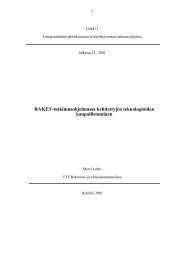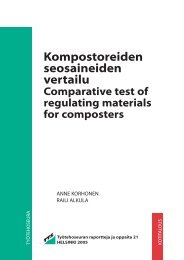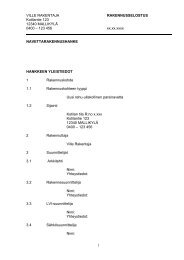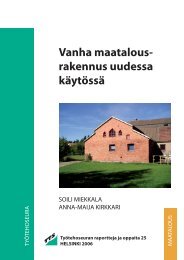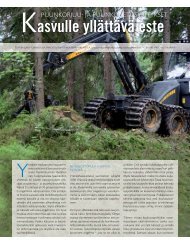Koko raportti pdf-muodossa - TTS
Koko raportti pdf-muodossa - TTS
Koko raportti pdf-muodossa - TTS
Create successful ePaper yourself
Turn your PDF publications into a flip-book with our unique Google optimized e-Paper software.
8<br />
Abstract<br />
Anneli Reisbacka and Arja Rytkönen, <strong>TTS</strong>-Institute. THE DOMESTIC<br />
APPLIANCE SALESPERSON AS THE CONSUMER’S INFORMATION<br />
SOURCE. LINKKI 2 Research programme on energy conservation decisions and<br />
behaviour. Publication 12/2000.<br />
The aim of the study was to survey the kind of information given to customers by<br />
domestic appliance sales staff and how the staff adapt available information to<br />
customers’ needs. The material was collected by recording on tape – without the<br />
salesperson’s knowledge – test shopping events in 58 stores. These included “shopping<br />
for” 31 washing machines and tumble dryers, 32 fridge freezers, 25 cookers and 29<br />
television sets and videotape recorders.<br />
Most of the salespersons were male (93%) and relatively young, nearly half of them<br />
(44%) under 30 years of age. In most of the stores service was good (53%) or<br />
satisfactory (34%). Poor service was provided by only 15% of the salespersons. Service<br />
varied according to the salesperson. The few saleswomen all provided good service.<br />
The price of the appliance was given in nearly all the test shopping events. Its location,<br />
installation and space demands were discussed in 5–33% of cases, depending on the<br />
appliance. The electricity consumption or energy efficiency of fridge freezers, washing<br />
machines and tumble dryers was discussed in 77% of cases. Electricity consumption<br />
was discussed in 72% of shopping events of the cooker, 46% of the television and 23%<br />
of the videotape recorder. The electricity consumption of entertainment appliances such<br />
as televisions and videotape recorders was generally considered to be low.<br />
The qualities most discussed were the following: washing machine capacity, spinning<br />
speed (92%) and wash result (74%); tumble dryer capacity (97%); fridge freezer volume<br />
(100%); oven capacity (40%), the differences between various types of hotplate (76%)<br />
and heating methods (52%); and the picture and sound qualities of televisions and video<br />
recorders and size of television screen (75%).<br />
The information provided by the sales staff varied from inadequate and misleading to<br />
accurate and practically applied information. Appliance-specific lists of matters to be<br />
discussed in the test shopping events were made for the study. These included the<br />
consumer’s needs, the measurements of the space reserved for the appliance, the<br />
installation space demands, general installation demands, the space required for use of<br />
the appliance, compatibility with other fixtures, environmental impact, performance,<br />
energy consumption and costs, operating properties, operational safety, price, guarantee,<br />
maintenance and the disposal of the old appliance. To raise the level of knowledge of<br />
sales staff, training is required. Consumers need guidelines to choose the right<br />
appliance.<br />
Keywords: domestic appliance salesperson, energy labelling, customer service,<br />
domestic appliance, consumer information



